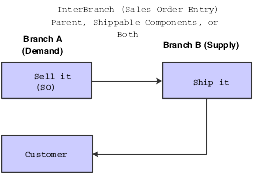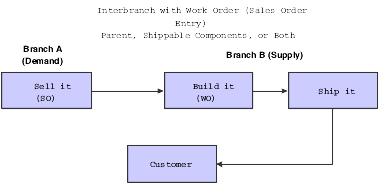Understanding Configured Item Interbranch Orders
Interbranch orders enable you to ship an item directly to the customer from another branch of the company. You can do interbranch orders for configured items.
The sale and interbranch that takes place between Branches A and B could be for the parent configured item or a component of the parent configured item. The component of the parent configured item could be a standard manufactured component, subassembly, or configured subassembly.
In the case of a sale and interbranch of a parent configured item, Branch A uses Sales Order Entry (P4210) to order and configure the item, based on customer request. However, Branch B supplies the parent configured item. Thus, when the order for the configured item is entered, the detail Branch becomes Branch B by default. Branch B then ships the item to the customer.
In the case of a sale involving an interbranch of a component of a parent configured item, Branch A uses Sales Order Entry to configure and order the parent configured item. The parent configured item is built in Branch A; however, a component is supplied by Branch B. The component item is shipped separately from the parent item. Thus, Branch A ships the parent item to the customer, and Branch B ships the component item to the customer.
This diagram illustrates the interbranch order process:

In some instances, Branch B might have to build the parent configured item or component of the configured item before it can be shipped to the customer.
This graphic illustrates the step of generating work orders to manufacture the item before it is shipped to the customer:
